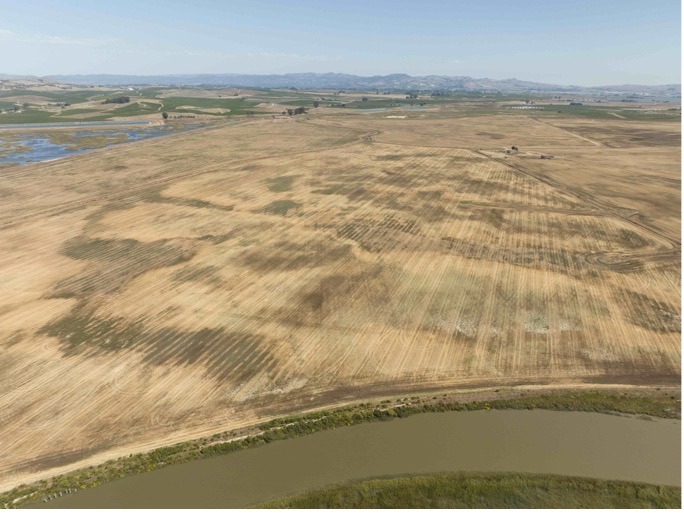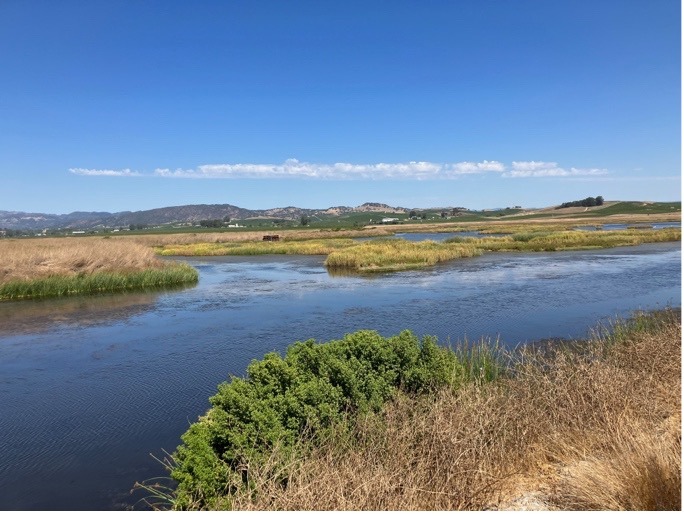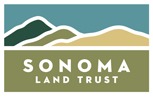Press Release
Sonoma Land Trust purchases another critical piece of historic wetland mosaic
Oct 3, 2023Ecosystem restoration is key to addressing sea level rise in the Bay Area
SANTA ROSA, CALIFORNIA Sonoma Land Trust, in partnership with the Natural Resources Conservation Service (NRCS), the San Francisco Bay Restoration Authority (Restoration Authority) and the Gordon and Betty Moore Foundation (Moore Foundation), is proud to announce the successful acquisition of the 1,150-acre Camp 4 property, a vital piece of the Sonoma Creek Baylands ecosystem. This collaborative effort marks significant progress toward the Land Trust’s strategic goal of permanently protecting and restoring 10,000 acres of historic baylands. This will ensure our region greater resilience against sea level rise and boost the conservation of threatened and endangered plant and animal species.
Situated in the heart of the Sonoma Creek Baylands, the property will be restored to tidal marsh wetlands after a century of agricultural use, most recently as an organic hay farm. Camp 4 sits between the San Pablo Bay National Wildlife Refuge and the Napa-Sonoma Marshes Wildlife Area and is encircled by seven miles of tidal slough channels. This makes it an essential part of the broader wetland network which, when restored, will act as the most critical defense area against rising sea levels in the San Francisco Bay Area.
The partnership between Sonoma Land Trust, NRCS, the Restoration Authority and the Moore Foundation underscores the long-term federal and regional commitment to preserving natural landscapes of the Bay Area. The property was purchased through a Wetland Reserve Easement (WRE) held by NRCS, and funding from the Restoration Authority and the Moore Foundation for the underlying fee title held by the Land Trust. The partnership will continue to collaborate to design and implement a comprehensive tidal marsh restoration plan, with the Land Trust taking on stewardship responsibilities until a suitable partner agency assumes ownership.
Since the 1980s, large properties in Marin, Napa, Solano, and Sonoma Counties along the San Pablo Bay have undergone key phases of restoration, including intentional levee breaches that converted dry areas into moisture-rich landscapes. Returning water back to the land is the first step in the transformation process and provides the foundation for life-sustaining wetland ecosystems to return.
The funding and partnerships that are now in place to protect Camp 4 are part of a larger scale effort to provide expansive areas for stormwater and runoff to flow into the bay, without overtopping levees and flooding roads and communities. When Camp 4 and adjacent agricultural and natural lands are restored and managed in a way that works together, this will reconnect wetlands and waterways spanning from the mountains to the bay.
“Camp 4 Ranch is the first acquisition to be funded by the revenue generated from Measure AA, the Bay Area’s regional shoreline restoration measure.” shared San Francisco Bay Restoration Authority Executive Officer Amy Hutzel. “Today’s acquisition of over one thousand acres of diked former baylands reflects the important role of local funding. The San Francisco Bay Restoration Authority granted Measure AA funding to Sonoma Land Trust to develop the Sonoma Creek Baylands Strategy in 2018, which identified Camp 4 as one of the most significant remaining opportunities for tidal wetland restoration, and a vital component of the Strategy’s high-level vision for protecting and restoring over 10,000 acres. In five short years, we are seeing the Strategy become a reality with momentous steps like this acquisition, which will lead to restoring and permanently protecting these wetlands. Thank you and congratulations to the Sonoma Land Trust, the Natural Resources Conservation Service, and all our local, state, and federal partners.”
“Land subsidence, rising tides, expensive levee maintenance and pumping costs, and a changing agricultural market have made hay farming increasingly difficult to sustain on the Camp 4 Ranch.” said Dean Kwasny, NRCS Easement Program Manager. “Our Wetland Reserve Easement Program offers landowners an opportunity to voluntarily retire marginal agricultural lands, and in the case of Camp 4, restore historic tidal wetlands for sea level rise mitigation, flood abatement, and fish and wildlife habitat.”
“This acquisition is especially important because the vast majority of San Francisco Bay’s tidal wetlands have been converted or destroyed,” said Dan Winterson, who manages the Conservation Portfolio at the Moore Foundation. “We’re happy to be able to support this effort in partnership with federal and state agencies as well as private entities.”
History of Camp 4: In a report by historian Arthur Dawson, the Camp 4 property was claimed under the Swampland Act of 1850, which provided the initial incentive for individuals to drain and dike off lands below the high tide line. It wasn’t until 1890 when this work shifted from human hands to steam-powered dredging machines that it really picked-up speed.
Around this time, Senator John P. Jones acquired 15,000 acres (25 square miles) of Sonoma Valley’s tidelands and drained them for agricultural use. Jones set up six ‘Camps’ with bunkhouses to accommodate the workers on his ranch. As many as two hundred horses were used to work the land and were housed in huge barns. Hay was the most popular crop and was exported to San Francisco to fuel the horse-drawn carriages of that era.
Over time, the converted tidelands dried out, the organic material decomposed, and they subsided as much as eight feet in elevation. In addition, these lands are no longer being replenished with sediment from tidal waters and upstream floodwaters from Sonoma Creek. Winter rains watered the dry-farmed oat hay, but the levees prevented the floodwater from spreading across the landscape, creating unintended upstream flooding. The first recorded flooding in the Schellville area occurred shortly after Jones’ dredges completed the first significant levee along Sonoma Creek in 1890.
Contribution to 30×30 goals: Camp 4 will be managed and protected to meet California’s 30×30 goals, the state’s initiative to conserve 30% of its lands and waters by 2030. Currently in Sonoma County, approximately 22% of our lands have been conserved due to the work of land trusts, county and other government agencies, and conservation partners like the Moore Foundation. To reach the goal of conserving 30% of the county by 2030, 78,000 more acres must be protected in the next seven years. Land trust acquisitions and conservation easements are a crucial part of reaching this goal, and Sonoma Land Trust’s work towards conserving 30×30 is helping to combat the biodiversity and climate crises.

Photo: Peter Essick

Photo: Becky Matsubara
The salt marsh harvest mouse is an indicator species of a healthy wetland habitat and has remained on the endangered list for fifty years due to habitat destruction. The Ridgeway’s rail is a near-threatened species whose population will also benefit from the restoration of habitat where pickleweed and other dense vegetation is planted which provides a safe refuge in a rising tide.
“Restoring the Camp 4 property is imperative because of the pace of sea-level rise and major flood events. We are grateful to the owners of the property who worked with NRCS and the Land Trust for several years to complete this transaction, and we appreciate their stewardship of the land as an organic farm. We also want to thank the funding partners for not only the acquisition grants, but an additional $13 million for restoration and stewardship costs. This is a terrific example of the positive impact that can be achieved when there is a clear strategy in place and we are all working towards a common goal.” said John McCaull, director of land acquisition at Sonoma Land Trust.
The acquisition and restoration of the Camp 4 property offers significant benefits for both the environment and the community:
- Wetland Expansion: This acquisition expands the protected wetlands area along San Pablo Bay by adding 1,150 acres, further safeguarding the delicate ecosystem.
- Resilience Against Sea Level Rise: The restoration efforts contribute to community and habitat resilience against the impacts of rising sea levels. The project aligns with Sonoma Land Trust’s Adapting to Rising Waters Strategy to protect and restore over 10,000 acres of baylands ecosystems.
- Enhanced Habitat Diversity: Large-scale restoration of wetland habitat enhances San Francisco Bay’s biodiversity, providing a home for a diverse range of plants, fish, birds, and other wildlife.
- Critical Wildlife Populations: The property will serve as a vital habitat for special-status plants, fish, and wildlife, including the endangered Ridgway’s rail and salt marsh harvest mouse. Additionally, it will support hundreds of thousands of waterfowl and shorebirds along the Pacific Flyway, contributing to their conservation.
- Concentration of Waterfowl: The restored property will welcome back more than 30 species of waterfowl, including a significant population of canvasback ducks—one of the largest concentrations in North America—and approximately 50 percent of the Pacific Flyway’s diving duck population.


Restoration on Camp 4 (image on the left) will transform the dry hay field into a dynamic wetland ecosystem that matches its neighboring parcels belonging to the wildlife refuge area (image on the right).
Access to the property is currently limited due to restrictions in place to protect natural wetland habitat and facilitate restoration and management as we transition from agricultural use. Visit https://sonomalandtrust.org/our-preserve-system/ecological-preserves/camp-4/ to learn more.
